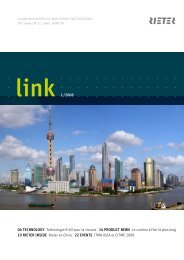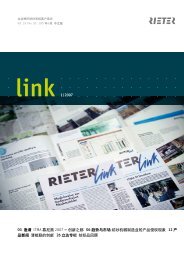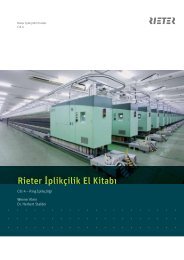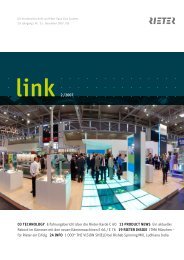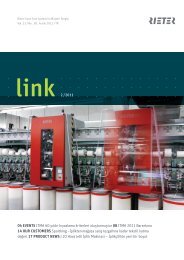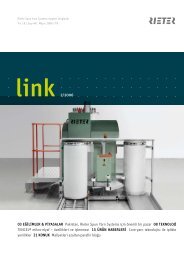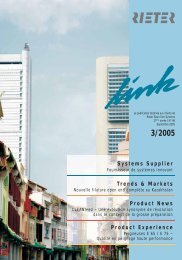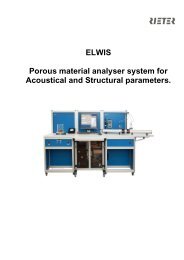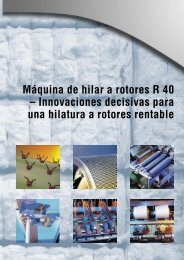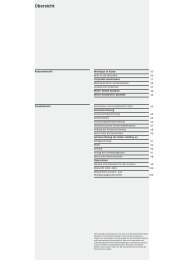link 1 /2010 04 Trends & MArKeTs Belarus textile market on ... - Rieter
link 1 /2010 04 Trends & MArKeTs Belarus textile market on ... - Rieter
link 1 /2010 04 Trends & MArKeTs Belarus textile market on ... - Rieter
You also want an ePaper? Increase the reach of your titles
YUMPU automatically turns print PDFs into web optimized ePapers that Google loves.
The customer magazine of <strong>Rieter</strong> Spun Yarn Systems<br />
Vol. 22. / No . 54 . January <str<strong>on</strong>g>2010</str<strong>on</strong>g> / EN<br />
<str<strong>on</strong>g>link</str<strong>on</strong>g> 1<br />
/<str<strong>on</strong>g>2010</str<strong>on</strong>g><br />
<str<strong>on</strong>g>04</str<strong>on</strong>g> <str<strong>on</strong>g>Trends</str<strong>on</strong>g> & <str<strong>on</strong>g>MArKeTs</str<strong>on</strong>g> <str<strong>on</strong>g>Belarus</str<strong>on</strong>g> <str<strong>on</strong>g>textile</str<strong>on</strong>g> <str<strong>on</strong>g>market</str<strong>on</strong>g> <strong>on</strong> track for the future 07 Our CusTOMers Yutex<br />
and Melange, a Kazakh success story 10 0 TeC�nO�O�� TeC�nO�O�� Impressive: the E 66 and E 76 combers in mill<br />
operati<strong>on</strong> 16 rIeTer InsIde “The <strong>Rieter</strong> Manual of Spinning”: a reference work of spinning know-how
2 <strong>Rieter</strong> . �InK 54 . 1 /<str<strong>on</strong>g>2010</str<strong>on</strong>g><br />
COnTenTs<br />
Cover:<br />
<strong>Rieter</strong> combing system with<br />
the E 76 and OMEGAlap E 35.<br />
Publisher:<br />
<strong>Rieter</strong> Spun Yarn Systems,<br />
resp<strong>on</strong>sible Edda Walraf.<br />
editor-in-chief:<br />
Nadia Qaud<br />
Copyright:<br />
© <str<strong>on</strong>g>2010</str<strong>on</strong>g> by <strong>Rieter</strong> Machine Works Ltd.,<br />
Klosterstrasse 20, CH-8406 Winterthur,<br />
www.rieter.com, rieter-<str<strong>on</strong>g>link</str<strong>on</strong>g>@rieter.com<br />
Reprints permitted, subject to prior approval;<br />
specimen copies requested.<br />
design and producti<strong>on</strong>:<br />
Marketing <strong>Rieter</strong> CZ s.r.o., Pavel Bielik<br />
Printing HRG s.r.o., Czech Republic<br />
03 edITOrIA�<br />
<str<strong>on</strong>g>Trends</str<strong>on</strong>g> & <str<strong>on</strong>g>MArKeTs</str<strong>on</strong>g><br />
<str<strong>on</strong>g>04</str<strong>on</strong>g> <str<strong>on</strong>g>Belarus</str<strong>on</strong>g> <str<strong>on</strong>g>textile</str<strong>on</strong>g> <str<strong>on</strong>g>market</str<strong>on</strong>g> <strong>on</strong> track for the future<br />
<str<strong>on</strong>g>Belarus</str<strong>on</strong>g> – formerly a member of the Soviet Uni<strong>on</strong> – is<br />
currently in a c<strong>on</strong>trolled development phase. A fascinating<br />
insight into the development of the <str<strong>on</strong>g>textile</str<strong>on</strong>g> industry in<br />
<str<strong>on</strong>g>Belarus</str<strong>on</strong>g>.<br />
Our CusTOMers<br />
07 �utex and Melange, a Kazakh success story<br />
The unique road to success of a Kazakh family who<br />
have <strong>on</strong>ly been in the <str<strong>on</strong>g>textile</str<strong>on</strong>g> business for 10 years. The<br />
milest<strong>on</strong>e reached to date is a vertically integrated <str<strong>on</strong>g>textile</str<strong>on</strong>g><br />
company with modern equipment.<br />
TeC�nO�O��<br />
10 Impressive: the e 66 and e 76 combers in mill<br />
operati<strong>on</strong><br />
Gentle combing with maximum output is a trademark<br />
feature of <strong>Rieter</strong> combers. The E 66/E 76 combers<br />
impress with outstanding quality.<br />
12 new rsB-d 22 autoleveler drawframe: single-head<br />
autoleveling quality <strong>on</strong> two heads<br />
14 swivel rather than c<strong>on</strong>tort! sWIVe�plate eVO is the<br />
answer<br />
15 “Magic EyE M1”: this magic eye sees everything<br />
rIeTer InsIde<br />
16 “The rieter Manual of spinning”: a reference work of<br />
spinning know-how<br />
The new, revised “<strong>Rieter</strong> Manual of Spinning” offers<br />
technical specialists, students and interested readers<br />
a multi-volume reference work with a practical focus <strong>on</strong><br />
short-staple spinning technology.
dear �InK readers<br />
The ec<strong>on</strong>omic situati<strong>on</strong> is still tense and investments<br />
have to be carefully c<strong>on</strong>sidered at such times. We<br />
too ask ourselves with each and every new purchase<br />
whether it is really necessary, and invest in machinery<br />
and technologies that give <strong>Rieter</strong> a competitive<br />
edge.<br />
Which are the key machines in the spinning mill?<br />
Which machines help you gain an advantage in the<br />
keenly c<strong>on</strong>tested yarn <str<strong>on</strong>g>market</str<strong>on</strong>g>? Machines that require<br />
modest capital investment and have a big impact <strong>on</strong><br />
the quality of the yarn produced, such as autoleveler<br />
drawframes and combers.<br />
All <strong>Rieter</strong>'s RSB drawframes feature high delivery<br />
speeds and high-precisi<strong>on</strong> autoleveling. Optimal<br />
combing-out, low fiber loss and low energy c<strong>on</strong>sumpti<strong>on</strong><br />
are the main characteristics of the E 66/<br />
E 76 combers.<br />
�ow can you gain a l<strong>on</strong>g-term competitive edge?<br />
With higher productivity, energy savings and improved<br />
raw material utilizati<strong>on</strong>. These have been the<br />
focus of our development engineers' work for many<br />
years. This is the <strong>on</strong>ly way spinning mills can reduce<br />
manufacturing costs over the l<strong>on</strong>g term. <strong>Rieter</strong> ring<br />
spinning machines achieve higher levels of efficiency,<br />
c<strong>on</strong>sume c<strong>on</strong>siderably less energy and produce<br />
ec<strong>on</strong>omically.<br />
Invest in training<br />
In additi<strong>on</strong> to the right machinery portfolio, well<br />
trained spinning mill pers<strong>on</strong>nel are the key to success.<br />
Knowledge and skill are the building blocks for<br />
high product quality and productivity. Training and<br />
pers<strong>on</strong>nel development in spinning mills are <strong>on</strong>ly<br />
possible if the available technological know-how is<br />
passed <strong>on</strong>.<br />
<strong>Rieter</strong> . �InK 54 . 1 /<str<strong>on</strong>g>2010</str<strong>on</strong>g><br />
EDITORIAL<br />
“The rieter Manual of spinning”<br />
The new “<strong>Rieter</strong> Manual of Spinning” textbooks lay<br />
the foundati<strong>on</strong> for spinning mills, instituti<strong>on</strong>s and<br />
universities worldwide to share <strong>Rieter</strong>'s technological<br />
know-how. <strong>Rieter</strong> will shortly make an <strong>on</strong>line editi<strong>on</strong><br />
of the manual – named “RIKIpedia” – available<br />
at www.rieter.com.<br />
Training pays off<br />
The better pers<strong>on</strong>nel are trained, the better equipped<br />
they are to adjust, operate and maintain the machines.<br />
Machine efficiency is improved, downtime is reduced.<br />
Invest in a single training sessi<strong>on</strong> and benefit from a<br />
lasting gain in efficiency. At our training courses you<br />
learn more about the technological relati<strong>on</strong>ships between<br />
the different process stages and learn how to optimize<br />
the efficiency of the entire spinning mill.<br />
Customized training<br />
Five instructors train our customers <strong>on</strong> the latest machines<br />
at the <strong>Rieter</strong> Training Center in Winterthur. The<br />
range of courses has now been adapted for different<br />
management levels. There has been an excellent resp<strong>on</strong>se<br />
to our seminars for mill managers. We now offer<br />
seminars for middle management. These courses focus<br />
<strong>on</strong> technological coordinati<strong>on</strong> of the machines and<br />
process optimizati<strong>on</strong>. In the machinery courses operators<br />
and maintenance pers<strong>on</strong>nel learn everything about<br />
drive engineering, electr<strong>on</strong>ics, programming and technology.<br />
We also train purchasers from department store<br />
chains so that they have some idea of the complexity<br />
of <str<strong>on</strong>g>textile</str<strong>on</strong>g> manufacturing, quality and their influence <strong>on</strong><br />
costs.<br />
We keep you informed via <strong>Rieter</strong> LINK about the extensive<br />
range that <strong>Rieter</strong> has to offer you: innovati<strong>on</strong>s<br />
in machinery and spare parts, technological<br />
expertise and training.<br />
9-100 •<br />
reto Thom<br />
Head Markets<br />
Winterthur<br />
reto.thom@rieter.com<br />
3
4 <strong>Rieter</strong> . �InK 54 . 1 /<str<strong>on</strong>g>2010</str<strong>on</strong>g><br />
TRENDS & MARKETS<br />
<str<strong>on</strong>g>Belarus</str<strong>on</strong>g> <str<strong>on</strong>g>textile</str<strong>on</strong>g> <str<strong>on</strong>g>market</str<strong>on</strong>g> <strong>on</strong> track<br />
for the future<br />
The ec<strong>on</strong>omy of <str<strong>on</strong>g>Belarus</str<strong>on</strong>g> – formerly a member of the soviet uni<strong>on</strong> – is currently<br />
in a c<strong>on</strong>trolled development phase, since it has not yet evolved into<br />
a free <str<strong>on</strong>g>market</str<strong>on</strong>g> ec<strong>on</strong>omy. A fascinating insight into the development of the<br />
<str<strong>on</strong>g>textile</str<strong>on</strong>g> industry in <str<strong>on</strong>g>Belarus</str<strong>on</strong>g>.<br />
Fig. 1 The rising<br />
nati<strong>on</strong> of <str<strong>on</strong>g>Belarus</str<strong>on</strong>g> came<br />
into being in 1991.<br />
Fig. 2 <str<strong>on</strong>g>Belarus</str<strong>on</strong>g>, located<br />
between Russia and<br />
Europe.<br />
<str<strong>on</strong>g>Belarus</str<strong>on</strong>g> is a nati<strong>on</strong> in Eastern Europe whose borders<br />
with the European Uni<strong>on</strong> – Poland, Latvia and<br />
Lithuania, to be exact – amount to <strong>on</strong>e third of their<br />
total length, while its other neighbors are Russia and<br />
the Ukraine. The country stretches 650 km from east<br />
to west at its widest point, and 560 km from north<br />
to south. In terms of surface area <str<strong>on</strong>g>Belarus</str<strong>on</strong>g> is the 13 th<br />
largest European country and therefore its largest<br />
landlocked nati<strong>on</strong>.<br />
Politics<br />
The country has been independent since 1991, when<br />
it emerged from the former Soviet Uni<strong>on</strong>. The country’s<br />
form of government is that of a presidential republic,<br />
of which Aleksandr Lukashenko has been<br />
president since 1994. The bi-cameral parliament is<br />
elected by popular vote. <str<strong>on</strong>g>Belarus</str<strong>on</strong>g> is officially a member<br />
of the “Uni<strong>on</strong> of Russia and <str<strong>on</strong>g>Belarus</str<strong>on</strong>g>”. Very good<br />
and intensive foreign relati<strong>on</strong>s are limited to <strong>on</strong>ly a<br />
few countries.<br />
ec<strong>on</strong>omy<br />
The <str<strong>on</strong>g>Belarus</str<strong>on</strong>g> ec<strong>on</strong>omy has not yet evolved into a free<br />
<str<strong>on</strong>g>market</str<strong>on</strong>g> ec<strong>on</strong>omy. The centrally planned ec<strong>on</strong>omy is<br />
still preferred as a political system. The country’s<br />
ec<strong>on</strong>omic situati<strong>on</strong> has been stable to date by virtue<br />
of very good ec<strong>on</strong>omic relati<strong>on</strong>s with Russia. Industry<br />
and agriculture are largely state-c<strong>on</strong>trolled.<br />
Increasing numbers of companies have been nati<strong>on</strong>alized<br />
again since 2005.<br />
<str<strong>on</strong>g>Belarus</str<strong>on</strong>g> therefore has <strong>on</strong>e of the world’s few ec<strong>on</strong>omies<br />
based <strong>on</strong> the state-capitalism model. Having<br />
been subsidized to date by preferential treatment for<br />
commodity prices, the ec<strong>on</strong>omy has got into difficulties<br />
since Russia raised the price of crude oil. Agriculture,<br />
which accounts for 15% of employment, is<br />
dominated by two main branches of activity, potato<br />
growing and cattle breeding. Important industrial<br />
sectors are <str<strong>on</strong>g>textile</str<strong>on</strong>g>s and timber processing. Within<br />
the Soviet Uni<strong>on</strong> machine manufacturing and the<br />
electr<strong>on</strong>ics industry were particularly encouraged.<br />
Ec<strong>on</strong>omic output in <str<strong>on</strong>g>Belarus</str<strong>on</strong>g> c<strong>on</strong>tracted when structures<br />
based <strong>on</strong> <str<strong>on</strong>g>market</str<strong>on</strong>g> ec<strong>on</strong>omy principles were introduced<br />
in 1990. Growth did not recommence until<br />
1996. 1990 levels were attained again in both agriculture<br />
and industry in 2001. Real per capita gross<br />
domestic product (GDP) was approx. US$ 4 620 in<br />
2007. Gross domestic product has increased c<strong>on</strong>tinuously<br />
in the past 10 years by 3.5 - 11.5% annually.<br />
According to UN figures, <str<strong>on</strong>g>Belarus</str<strong>on</strong>g> has the highest<br />
standard of living within the Comm<strong>on</strong>wealth of Independent<br />
States (CIS). Average m<strong>on</strong>thly income has<br />
grown from US$ 20 to US$ 225 in the past 10 years.<br />
One fly in the ointment has been the relatively high<br />
inflati<strong>on</strong> rates, in some cases at double-digit percentages,<br />
in recent years.
Fig. 3 The office<br />
of <strong>Rieter</strong>’s agent is<br />
located in Minsk, the<br />
capital of <str<strong>on</strong>g>Belarus</str<strong>on</strong>g>.<br />
The <str<strong>on</strong>g>textile</str<strong>on</strong>g> industry<br />
<str<strong>on</strong>g>Belarus</str<strong>on</strong>g> is <strong>on</strong>e of the largest apparel and <str<strong>on</strong>g>textile</str<strong>on</strong>g> manufacturers<br />
in the CIS. The apparel industry survived<br />
the collapse of the Soviet Uni<strong>on</strong> better – compared<br />
with other successor states – due to government<br />
support. From today’s standpoint the impact of this<br />
government support <strong>on</strong> manufacturers’ internati<strong>on</strong>al<br />
competitiveness has not been unreservedly positive.<br />
There is a lack of capital for investment in<br />
productivity and quality. Some plants are making<br />
good progress toward investing systematically and<br />
adapting to the prevailing circumstances. The country<br />
still has some advantages to offer as an industrial<br />
locati<strong>on</strong> which can be exploited: qualified and disciplined<br />
pers<strong>on</strong>nel, low labor costs and intact c<strong>on</strong>necti<strong>on</strong>s<br />
with the Russian <str<strong>on</strong>g>market</str<strong>on</strong>g>. Funds are also being<br />
selectively allocated to updating facilities within the<br />
scope of government resources.<br />
Light industry in <str<strong>on</strong>g>Belarus</str<strong>on</strong>g>, which includes the manufacture<br />
of <str<strong>on</strong>g>textile</str<strong>on</strong>g>s, garments and shoes, totals some<br />
500 businesses, half of which produce <str<strong>on</strong>g>textile</str<strong>on</strong>g>s and<br />
apparel. Sales revenues in 2007 amounted to some<br />
US$ 1.52 billi<strong>on</strong>. Al<strong>on</strong>gside the traditi<strong>on</strong>al <str<strong>on</strong>g>textile</str<strong>on</strong>g> industry,<br />
fiber producti<strong>on</strong> is an important factor. The<br />
first viscose fibers were manufactured in Mogilev as<br />
l<strong>on</strong>g ago as 1930. Polyester and polyamide have also<br />
been produced at various locati<strong>on</strong>s since 1965. In<br />
1990, shortly before the collapse of the Soviet Uni<strong>on</strong>,<br />
more than 50% of all manmade fibers and yarns<br />
were produced in what is now <str<strong>on</strong>g>Belarus</str<strong>on</strong>g>. Virtually all<br />
manmade fibers for <str<strong>on</strong>g>textile</str<strong>on</strong>g> and technical yarns are<br />
now manufactured in the country. Total output in<br />
2007 amounted to some 228 000 t<strong>on</strong>nes.<br />
Another important fiber is linen, a natural product<br />
that is cultivated in large quantities in <str<strong>on</strong>g>Belarus</str<strong>on</strong>g>. Today<br />
<str<strong>on</strong>g>Belarus</str<strong>on</strong>g> is already the fourth-largest producer<br />
of linen worldwide and exports more than half of its<br />
linen output. Producti<strong>on</strong> is to be increased by a further<br />
60 000 t<strong>on</strong>nes per year. Orsha Linen Mill, <strong>on</strong>e<br />
of the largest linen producers in Europe, processes<br />
<strong>on</strong>e-third of the local flax crop into approx. 3 milli<strong>on</strong><br />
square meters of linen fabric annually.<br />
<strong>Rieter</strong> . �InK 54 . 1 /<str<strong>on</strong>g>2010</str<strong>on</strong>g><br />
TRENDS & MARKETS<br />
rieter’s presence<br />
<strong>Rieter</strong> has delivered the following machines to various<br />
<str<strong>on</strong>g>textile</str<strong>on</strong>g> mills since <str<strong>on</strong>g>Belarus</str<strong>on</strong>g> became independent:<br />
UNIfloc machines, cards, drawframes, combers, roving<br />
frames, ring spinning machines and rotor spinning<br />
machines.<br />
In absolute terms, no great quantities have been delivered,<br />
but <strong>Rieter</strong> nevertheless has a large <str<strong>on</strong>g>market</str<strong>on</strong>g><br />
share in <str<strong>on</strong>g>Belarus</str<strong>on</strong>g>. <strong>Rieter</strong>’s agent, with headquarters<br />
in Germany and a very active office in the capital city<br />
of Minsk, has made a significant c<strong>on</strong>tributi<strong>on</strong> to our<br />
success. Local knowledge of the <str<strong>on</strong>g>market</str<strong>on</strong>g> and above<br />
all good relati<strong>on</strong>ships with customers and the “Bellegprom<br />
C<strong>on</strong>cern” have enabled <strong>Rieter</strong> to establish a<br />
str<strong>on</strong>g positi<strong>on</strong> in this <str<strong>on</strong>g>market</str<strong>on</strong>g>.<br />
Potential <str<strong>on</strong>g>textile</str<strong>on</strong>g> mill developments<br />
Private investment in machinery by <str<strong>on</strong>g>Belarus</str<strong>on</strong>g> customers<br />
is possible in <strong>on</strong>ly very few cases. The “Bellegprom<br />
C<strong>on</strong>cern” was established in 1992 and currently represents<br />
about 120 plants scattered throughout the<br />
country. All these companies employ a total of some<br />
100 000 pers<strong>on</strong>nel. 16 plants with 30 000 employees<br />
are engaged in <str<strong>on</strong>g>textile</str<strong>on</strong>g> producti<strong>on</strong>, accounting for<br />
39% of Bellegprom’s sales revenues.<br />
In recent years and the current year a number of minor<br />
and also major investments have been approved<br />
for the selective modernizati<strong>on</strong> of existing facilities.<br />
<strong>Rieter</strong> has planned and sold updated facilities<br />
to three customers in this c<strong>on</strong>text. Some of these installati<strong>on</strong>s<br />
have already come into operati<strong>on</strong>.<br />
Lots of <str<strong>on</strong>g>textile</str<strong>on</strong>g> engineering expertise exists in <str<strong>on</strong>g>Belarus</str<strong>on</strong>g>.<br />
Our customers’ requirements have been very<br />
diverse, including the producti<strong>on</strong> of sewing thread,<br />
linen yarns and blended yarns (tuft blending with<br />
UNIblend) – <strong>on</strong> ring spinning or rotor spinning machines.<br />
Planning the installati<strong>on</strong>s and machine c<strong>on</strong>figurati<strong>on</strong>s<br />
was therefore technically demanding and<br />
varied.<br />
5
6 <strong>Rieter</strong> . �InK 54 . 1 /<str<strong>on</strong>g>2010</str<strong>on</strong>g><br />
TRENDS & MARKETS<br />
Fig. 4 Flowering splendor –<br />
a field of linen.<br />
Fig. 5 The flax stems are first<br />
dried in preparati<strong>on</strong> for fiber<br />
processing.<br />
Fig. 6 Characteristic features<br />
of linen – slight thickening,<br />
creased appearance, smooth,<br />
cool hand and slight gloss.<br />
Background informati<strong>on</strong> <strong>on</strong> linen<br />
Linen is a fiber obtained from the flax plant which<br />
was already being processed 6 000 to 7 000 years<br />
ago. Starting in the late 19 th century – during the<br />
Industrial Revoluti<strong>on</strong> – linen was superseded by<br />
cott<strong>on</strong>, which was cheaper and easier to process industrially.<br />
Nowadays flax is gaining in importance<br />
again as an ecological natural fiber. Linen is the <strong>on</strong>ly<br />
fiber indigenous to Western Europe which is available<br />
<strong>on</strong> the <str<strong>on</strong>g>market</str<strong>on</strong>g> in c<strong>on</strong>trolled biological quality<br />
(Fig. 4).<br />
The annual plant must be re-sown each year. However,<br />
flax can <strong>on</strong>ly be grown <strong>on</strong> the same land every<br />
seven years.<br />
The flax fiber is obtained from the stems of the flax<br />
plant (Fig. 5). It is a bast fiber, bound together in<br />
bundles. These bundles can be separated chemically<br />
into individual fibers by cott<strong>on</strong>izati<strong>on</strong> – this is<br />
the <strong>on</strong>ly practicable producti<strong>on</strong> method for preparing<br />
the fibers (9 - 70 mm l<strong>on</strong>g) for short staple spinning.<br />
Linen can also be manufactured without using modern<br />
engineering methods, but the processing of linen<br />
fibers is complicated and labor-intensive. L<strong>on</strong>g fibers<br />
are usually spun into threads using the wet spinning<br />
method. Short fibers are usually spun dry.<br />
Future prospects<br />
Low labor and infrastructure costs, their excellent<br />
geographical locati<strong>on</strong> relative to the large European<br />
<str<strong>on</strong>g>market</str<strong>on</strong>g>s and <strong>on</strong>going good relati<strong>on</strong>s with Russia<br />
should enable companies in <str<strong>on</strong>g>Belarus</str<strong>on</strong>g> to hold their<br />
own against the global competiti<strong>on</strong>. Well trained pers<strong>on</strong>nel<br />
with technical know-how and a background of<br />
<str<strong>on</strong>g>textile</str<strong>on</strong>g> experience are available. Local fiber producti<strong>on</strong><br />
– linen, viscose and polyester – can be optimally<br />
utilized as synergies.<br />
Both rotor and ring spinning are suitable spinning<br />
processes. Linen yarns are coarse and at the same<br />
time feel soft. The properties of the yarn and the fabric<br />
can be influenced c<strong>on</strong>siderably by blending with<br />
cott<strong>on</strong>, viscose and other fibers.<br />
Linen fabrics have traditi<strong>on</strong>ally been used for bed<br />
linen, table linen and household linen. They have<br />
been supplanted in these applicati<strong>on</strong>s by cheaper<br />
cott<strong>on</strong>. New spheres of applicati<strong>on</strong> such as apparel<br />
and furnishing fabrics are being added, especially in<br />
the shape of hand-woven, high-price products. Linen<br />
fibers are also being used for technical fabrics and as<br />
replacement material for asbestos fibers.<br />
Linen’s share of global fiber supplies is <strong>on</strong>ly about<br />
2%. World output amounts to some two milli<strong>on</strong><br />
t<strong>on</strong>nes annually. The largest areas under cultivati<strong>on</strong><br />
are in China (161 000 hectares), the EU (France<br />
and Belgium, 102 740 hectares), Russia (89 210<br />
hectares), <str<strong>on</strong>g>Belarus</str<strong>on</strong>g> (71 000 hectares), the Ukraine<br />
(23 600 hectares) and Egypt (8 900 hectares). Interest<br />
in processing linen in large-scale industrial<br />
quantities is growing steadily. The ecological aspect<br />
is certainly a driving factor, and any<strong>on</strong>e who<br />
has worn linen knows how good it feels <strong>on</strong> the skin<br />
(Fig. 6).<br />
However, the investment required to keep pace with<br />
world <str<strong>on</strong>g>market</str<strong>on</strong>g> standards is enormous. If these investments<br />
can be made, <str<strong>on</strong>g>Belarus</str<strong>on</strong>g> has good prospects for<br />
becoming a major <str<strong>on</strong>g>textile</str<strong>on</strong>g> trading partner for Europe<br />
with high-quality and especially exclusive products.<br />
9-102 •<br />
Peter spirgi<br />
Sales Eastern Europe<br />
Winterthur<br />
peter.spirgi@rieter.com
�utex and Melange, a Kazakh<br />
success story<br />
The unique road to success of a Kazakh family who have <strong>on</strong>ly been in<br />
the <str<strong>on</strong>g>textile</str<strong>on</strong>g> business for 10 years. The starting point was the ambiti<strong>on</strong> to<br />
get a small cott<strong>on</strong> spinning mill in a disused group of <str<strong>on</strong>g>textile</str<strong>on</strong>g> enterprises<br />
from the soviet era up and running. A spinning mill full of machinery of<br />
an age that would make even Methuselah envious and which had specialists<br />
shaking their heads in disbelief. The milest<strong>on</strong>e reached to date<br />
is a vertically integrated <str<strong>on</strong>g>textile</str<strong>on</strong>g> company with modern equipment.<br />
Fig. 1 Kazakhstan,<br />
which became independent<br />
in 1991, is the<br />
world’s ninth-largest<br />
country with a surface<br />
area of 2 724 900 km².<br />
When the Republic of Kazakhstan became a sovereign<br />
state in December 1991, the Kazakh people<br />
took the plunge from a socialist, centrally planned<br />
ec<strong>on</strong>omy into a free <str<strong>on</strong>g>market</str<strong>on</strong>g> ec<strong>on</strong>omy (Fig. 1). However,<br />
in the process the authorities had overlooked<br />
the fact that a certain capital stock, established infrastructure<br />
and an experienced business community<br />
was necessary for this to succeed. Since Moscow’s<br />
influence had been very powerful up to then and independence<br />
was granted with empty coffers, the<br />
c<strong>on</strong>sequences were predictable: the lack of capital,<br />
know-how and managers propelled Kazakhstan into<br />
a deep recessi<strong>on</strong> that amounted to a total wipe-out.<br />
Under the c<strong>on</strong>descending smiles of neighbors, the<br />
struggle to overcome this predicament commenced.<br />
<strong>Rieter</strong> . �InK 54 . 1 /<str<strong>on</strong>g>2010</str<strong>on</strong>g><br />
OUR CUSTOMERS<br />
Kazakhstan’s natural resources<br />
The rescue is largely attributable to Kazakhstan’s<br />
wealth in natural resources. Mendeleyev could probably<br />
have completed his periodic table of elements<br />
here. Rising oil prices and the c<strong>on</strong>stantly growing<br />
appetite of the world <str<strong>on</strong>g>market</str<strong>on</strong>g> for steel, ir<strong>on</strong> and<br />
other metals fed the flow of cash into the country.<br />
This got trade and change moving in the mid-1990s.<br />
Young, highly educated Kazakhs established powerful<br />
banks. Some people earned lots of m<strong>on</strong>ey in a<br />
short time. The government recognized the dangers<br />
of short-sighted growth and set itself ambitious targets:<br />
Kazakhstan was to become <strong>on</strong>e of the 50 most<br />
highly developed countries in the world in the years<br />
to come. This meant promoting infrastructure and<br />
science, but above all manufacturing industry and<br />
agriculture, so that the country as a whole and its inhabitants<br />
can benefit.<br />
Birth of the modern <str<strong>on</strong>g>textile</str<strong>on</strong>g> industry<br />
The birth of the modern Kazakh <str<strong>on</strong>g>textile</str<strong>on</strong>g> industry came<br />
with the establishment of the state development<br />
bank and the specificati<strong>on</strong> of priority industrial sectors,<br />
so-called clusters. While manufacturing industry<br />
was hardly likely to develop with the backing of<br />
frightfully expensive loans from commercial banks,<br />
the development bank offered advantageous terms<br />
and c<strong>on</strong>diti<strong>on</strong>s. This brought into acti<strong>on</strong> business<br />
people in the far south of the country, where cott<strong>on</strong><br />
is grown, who saw their opportunity and future in<br />
<str<strong>on</strong>g>textile</str<strong>on</strong>g> manufacturing.<br />
The founders of what was then the ADAL company,<br />
the members of the family who now c<strong>on</strong>trol the small<br />
empire which includes Yutex, Yutex KZ and Melange,<br />
were am<strong>on</strong>g the initial pi<strong>on</strong>eers. A small loan was<br />
obtained to buy up plants in several countries. Lots<br />
of water flowed down the Syr Daya, <strong>on</strong>e of the largest<br />
rivers in southern Kazakhstan, and lots of cash was<br />
invested before the first yarn was spun in the company’s<br />
own mills.<br />
Fig. 2 The Yutex company’s new spinning premises.<br />
7
8 <strong>Rieter</strong> . �InK 54 . 1 /<str<strong>on</strong>g>2010</str<strong>on</strong>g><br />
OUR CUSTOMERS<br />
Fig. 3 State President<br />
Nursultan Nasarbayev<br />
starts up the UNIfloc<br />
A 11 at the Yutex<br />
opening cerem<strong>on</strong>y.<br />
The installati<strong>on</strong> includes legendary <strong>Rieter</strong> machines<br />
such as <strong>on</strong>e of the first A 1/2 bale openers, and<br />
also B 2/2, B 7/3, B 5/5, C 4, SB 51, RSB 51 and<br />
6 RU 14 A machines. These machines still produce<br />
quite passable yarns in the coarse count range.<br />
The new ring spinning installati<strong>on</strong><br />
With the experience gained and a number of specialists<br />
familiar with the tasks involved, the company<br />
ventured <strong>on</strong> its first larger-scale project, a ring<br />
spinning installati<strong>on</strong> for combed yarns with a total<br />
of 20 400 G 33 spindles. The c<strong>on</strong>tract was signed<br />
in September 2003. From that day <strong>on</strong>ward, not a<br />
year has passed in which the customer has not c<strong>on</strong>tinued<br />
to invest in the future. Just as the ring spinning<br />
mill started to produce high-quality yarn from<br />
locally available Kazakh cott<strong>on</strong>, the family had already<br />
signed a loan agreement to upgrade the Melange<br />
company (formerly ADAL).<br />
Vertical integrati<strong>on</strong><br />
The challenge facing <strong>Rieter</strong> was not so much in engineering<br />
as in providing know-how for commercial exploitati<strong>on</strong>.<br />
<strong>Rieter</strong>’s deliveries amounted to some part<br />
of the total c<strong>on</strong>tract. However, the customer and its<br />
bank entrusted the entire letter of credit to <strong>Rieter</strong>.<br />
<strong>Rieter</strong>’s Commercial Department did a perfect job –<br />
the customer was really enthusiastic – and a weaving<br />
mill as well as yarn and fabric finishing facilities were<br />
set up at a stroke. This move laid the foundati<strong>on</strong> for<br />
expansi<strong>on</strong> from a pure yarn manufacturer to a vertically<br />
integrated group. This was new territory for the<br />
company and lots of effort and energy were expended<br />
before this route could be embarked <strong>on</strong>.<br />
After handling this project, <strong>Rieter</strong> was not “merely”<br />
a supplier, but primarily a partner and mentor. The<br />
customer acquired a knitting mill and a complete garment<br />
manufacturing plant with embroidery facility.<br />
The company exhibited its own bed linen and toweling<br />
products for the first time in Germany at Heimtextil<br />
2009 in Frankfurt/Main in January 2009.<br />
Further modernizati<strong>on</strong><br />
However, the owners’ plans were not yet finished:<br />
there were still old machines standing around at Melange<br />
which required more repair and maintenance<br />
work than they produced material. Processing and<br />
finishing capacity was also not yet being adequately<br />
utilized. <strong>Rieter</strong> received two orders in quick successi<strong>on</strong>:<br />
the first task c<strong>on</strong>cerned the modernizati<strong>on</strong><br />
and expansi<strong>on</strong> of manufacturing facilities at Melange<br />
and Yutex (Fig. 3), the sec<strong>on</strong>d order was for a completely<br />
new spinning mill and weaving plant, which<br />
was planned for the free trade z<strong>on</strong>e in Shymkent.<br />
While some machines are currently being busily assembled,<br />
the others are already <strong>on</strong> the way to their<br />
destinati<strong>on</strong>.<br />
The list of machinery supplied by <strong>Rieter</strong> shows what<br />
has been delivered within the space of 5 years:<br />
• 5 complete blowroom lines with 10 VISION<br />
SHIELD units<br />
• 47 C 60 cards<br />
• 35 drawframes<br />
• 2 UNIlaps<br />
• 10 combers<br />
• 4 roving frames<br />
• 21 G 33 ring spinning machines with a total<br />
of 25 200 spindles<br />
• 31 R 40 rotor spinning machines with a total<br />
of 12 340 spinning boxes
Fig. 4 10 combers and<br />
2 UNIlap machines<br />
ensure optimum sliver<br />
preparati<strong>on</strong> of combed<br />
yarns.<br />
Fig. 5 High-quality<br />
ring-spun yarn is<br />
produced <strong>on</strong> 21<br />
G 33 ring spinning<br />
machines.<br />
Some 4 800 t<strong>on</strong>nes of combed ring-spun yarn and<br />
21 500 t<strong>on</strong>nes of carded rotor-spun yarn are produced<br />
annually <strong>on</strong> these machines, all 100% cott<strong>on</strong><br />
(Fig. 4 / 5). ). This corresp<strong>on</strong>ds approximately to the<br />
c<strong>on</strong>sumpti<strong>on</strong> of 30 000 bales of cott<strong>on</strong>, i.e. some<br />
20% of Kazakhstan’s total cott<strong>on</strong> output.<br />
These investments were all made without foreign<br />
cash or foreign guarantees. All the funds came from<br />
Kazakhstan. Things may move faster and have larger<br />
<strong>Rieter</strong> . �InK 54 . 1 /<str<strong>on</strong>g>2010</str<strong>on</strong>g><br />
OUR CUSTOMERS<br />
dimensi<strong>on</strong>s in other <str<strong>on</strong>g>market</str<strong>on</strong>g>s, but experts <strong>on</strong> the regi<strong>on</strong><br />
recognize the significance of this achievement.<br />
In future almost everything can be processed at Yutex,<br />
Yutex KZ and Melange. In additi<strong>on</strong> to the <strong>Rieter</strong><br />
installati<strong>on</strong>s, the machine portfolio also includes<br />
some 250 Dornier weaving machines, a number of<br />
circular knitting machines and processing and finishing<br />
facilities which handle some 40 milli<strong>on</strong> running<br />
meters annually. Customers in this regi<strong>on</strong> certainly<br />
aren’t unaffected by the financial crisis, either. The<br />
Russian and Kazakh <str<strong>on</strong>g>market</str<strong>on</strong>g>s in particular are being<br />
severely disrupted. However, the customer is c<strong>on</strong>fident<br />
of being well placed for the upturn that will follow<br />
the crisis.<br />
You will find further informati<strong>on</strong> <strong>on</strong> the homepage at<br />
www.<str<strong>on</strong>g>textile</str<strong>on</strong>g>s.kz. 9-101 •<br />
The author also wishes to thank other customers<br />
am<strong>on</strong>g the still small community<br />
of <str<strong>on</strong>g>textile</str<strong>on</strong>g> entrepreneurs in Kazakhstan<br />
who have expressed their c<strong>on</strong>fidence in<br />
<strong>Rieter</strong>, especially the Allians Kazakhskiy<br />
Russkiy Tekstil and OXY TEXTILE. Projects<br />
in Kazakhstan have become progressively<br />
larger, and also more complicated. All<br />
these projects are the result of tremendous<br />
teamwork and would hardly have<br />
been possible without the know-how of<br />
<strong>Rieter</strong>’s Commercial Department and the<br />
efforts of the Service Department. Many<br />
thanks are due to all those who sacrificed<br />
many a weekend and c<strong>on</strong>tributed to the<br />
fact that <strong>Rieter</strong> has a large share of the<br />
<str<strong>on</strong>g>market</str<strong>on</strong>g> in Kazakhstan.<br />
Jens-uwe Bockhahn<br />
Sales Central Asian CIS<br />
Winterthur<br />
jens-uwe.bockhahn@rieter.com<br />
9
10 <strong>Rieter</strong> . �InK 54 . 1 /<str<strong>on</strong>g>2010</str<strong>on</strong>g><br />
TECHNOLOGY<br />
Impressive: the e 66 and e 76<br />
combers in mill operati<strong>on</strong>s<br />
�entle combing at maximum output is a trademark feature of rieter<br />
combers. The e 66/e 76 combers have been operating under mill c<strong>on</strong>diti<strong>on</strong>s<br />
for some time. Customers’ standards differ, but the feedback is<br />
unanimous: these combers impress with their outstanding quality.<br />
Fig. 1 The <strong>Rieter</strong><br />
combing system in mill<br />
operati<strong>on</strong>s – the E 66<br />
with 500 nips/minute.<br />
At the end of 2009 more than 450 combers E 66/<br />
E 76 were already in producti<strong>on</strong> <strong>on</strong> the global <str<strong>on</strong>g>market</str<strong>on</strong>g>.<br />
Further orders are being processed. Customers<br />
comment positively <strong>on</strong> the new E 66/E 76 combers<br />
(Fig. 1). All customers using 1 1/8˝ cott<strong>on</strong> have<br />
achieved the 500 nips/minute quoted in the leaflet<br />
and therefore output of up to 74 kg/h.<br />
Impressive technology<br />
<strong>Rieter</strong> has the greatest store of experience in combing;<br />
its combing philosophy is trailblazing. The three<br />
pillars <strong>on</strong> which <strong>Rieter</strong>’s high-performance combing<br />
philosophy is based are:<br />
• Very high nip rate (up to 500 nips/min.)<br />
• Very high batt weight (up to 80 g/m)<br />
• Overfeed.<br />
The first two parameters are determined by the raw<br />
material, i.e. its staple length. The advantage of the<br />
high nip rate is the short dwell time of the fibers in<br />
the circular comb clothing. Combing is gentle and<br />
rapid, so the fibers are subject to little stress. Overel<strong>on</strong>gati<strong>on</strong><br />
of the fibers is prevented and the stress/<br />
strain ratio of the yarn is thus not affected.<br />
High batt weight enhances the so-called self-cleaning<br />
effect, i.e. when the combed fiber tuft is detached<br />
fiber/fiber fricti<strong>on</strong> occurs between the detached fibers<br />
and those remaining in the lap. This fiber/fiber<br />
fricti<strong>on</strong> in additi<strong>on</strong> to the acti<strong>on</strong> of the circular and<br />
top combs enables neps, dust and trash to be removed.<br />
Overfeed proves its worth again and again,<br />
since it facilitates superior fiber selecti<strong>on</strong> and combs<br />
out most efficiently. This is also dem<strong>on</strong>strated in the<br />
l<strong>on</strong>g staple range. Numerous customers have recognized<br />
after adjusting these parameters that they<br />
have been able to improve quality and at the same<br />
time increase output (Fig. 2, below).<br />
Impressive quality<br />
C<strong>on</strong>sistent noil removal and good imperfecti<strong>on</strong> values<br />
(Fig. 2), tenacity and el<strong>on</strong>gati<strong>on</strong> have been dem<strong>on</strong>strated<br />
in the field. Classimat readings (Fig. 3),<br />
which are important for customers, are also impressive.<br />
At up to 50 nips/min. faster, the E 66 and E 76<br />
achieved at least equal or even better quality compared<br />
to the E 65/E 75 predecessor models.<br />
Impressive know-how<br />
A technologically perfect lap and very good lap<br />
take-off behavior <strong>on</strong> the comber are essential prec<strong>on</strong>diti<strong>on</strong>s<br />
in high-performance combing with batt<br />
weights of up to 80 g/m. These criteria are fulfilled<br />
by the laps from the UNIlap E 32 and the high-output<br />
OMEGAlap E 35.<br />
As regards the comber, optimally coordinated technology<br />
comp<strong>on</strong>ents and sequences of moti<strong>on</strong> are necessary<br />
to realize this combing philosophy. This has<br />
also been achieved at 500 nips/min. using <strong>Rieter</strong>’s<br />
own CAPD software. Another important advantage is<br />
the in-house development of nippers, circular combs<br />
and top combs, the core elements of the comber.
Fig. 2 Customer test results: imperfecti<strong>on</strong>s<br />
IPI / 1 000 m IPI / 1 000 m<br />
60<br />
50<br />
40<br />
30<br />
20<br />
10<br />
0<br />
200<br />
180<br />
160<br />
140<br />
120<br />
100<br />
80<br />
60<br />
40<br />
20<br />
0<br />
11<br />
0<br />
33<br />
22<br />
88<br />
32<br />
132<br />
55<br />
ne 62, l<strong>on</strong>g staple cott<strong>on</strong> 1 7/16˝ (36 mm), 20% noil<br />
35<br />
30<br />
25<br />
20<br />
15<br />
10<br />
5<br />
0<br />
e 65<br />
56 ktex / 30,6 kg/h<br />
320 nips/min.<br />
7<br />
27<br />
69<br />
103<br />
Thin places -50% Thick places +50% Neps +200%<br />
Total IPI CVm<br />
Fig. 3 Customer test results: Classimat values<br />
Faults [1/100 km]<br />
ne 40, medium staple cott<strong>on</strong> 1 1/8˝ (29 mm), 15% noil<br />
9.68<br />
e 65<br />
450 nips/min., 65.3 kg/h<br />
10,68 10,42<br />
28<br />
2<br />
3<br />
33<br />
1<br />
e 66<br />
56 ktex / 30,6 kg/h<br />
320 nips/min.<br />
ne 40, medium staple cott<strong>on</strong> 1 1/8˝ (29 mm)<br />
e 65<br />
450 nips/min.<br />
18<br />
22<br />
6<br />
1<br />
9.62<br />
30<br />
24<br />
3<br />
53<br />
e 66<br />
500 nips/min., 71.9 kg/h<br />
63<br />
22<br />
93<br />
e 66<br />
68 ktex / 48,8 kg/h<br />
420 nips/min.<br />
e 66<br />
500 nips/min.<br />
10,32<br />
Short thick places L<strong>on</strong>g thick places L<strong>on</strong>g thin places Total defects<br />
11.0<br />
9.0<br />
8.0<br />
7.0<br />
6.0<br />
5.0<br />
4.0<br />
3.0<br />
2.0<br />
1.0<br />
11.0<br />
10.5<br />
10.0<br />
9.5<br />
9.0<br />
8.5<br />
8.0<br />
7.5<br />
7.0<br />
6.5<br />
6.0<br />
CVm [%]<br />
CVm [%]<br />
Anja Knick<br />
<strong>Rieter</strong> . �InK 54 . 1 /<str<strong>on</strong>g>2010</str<strong>on</strong>g><br />
TECHNOLOGY<br />
Extensive experience gained over many years enables<br />
characteristics such as tooth shape, tooth crosssecti<strong>on</strong>,<br />
tooth arrays, fr<strong>on</strong>t angle and gap width to be<br />
ideally coordinated.<br />
Other impressive facts<br />
There are other powerful arguments in favor of the<br />
new combers in additi<strong>on</strong> to technology, quality and<br />
know-how:<br />
• The lowest energy c<strong>on</strong>sumpti<strong>on</strong> compared to all<br />
other competitors: 3.5 kW at 500 nips/min.<br />
• The quietest comber: 86 dB at 500 nips/min.<br />
• Low space requirements: up to 50% less than<br />
other European combers<br />
• Very low oil c<strong>on</strong>sumpti<strong>on</strong> (very low wear in the<br />
transmissi<strong>on</strong>): 5 liters for 4 000 operating hours<br />
• Very good top comb self-cleaning due to the specially<br />
developed tooth shape, which prevents<br />
short fibers from wrapping around it<br />
• The slivers from the 8 combing heads can easily<br />
be threaded into the drafting system<br />
• High machine efficiency of up to 96% (E 76) due<br />
to trouble-free running behavior<br />
• Superior lap quality with mill-proven UNIlap E 32<br />
and OMEGAlap E 35 combing preparati<strong>on</strong>.<br />
Output of up to 74 kg/h, uniformly good fiber selecti<strong>on</strong>,<br />
very low energy c<strong>on</strong>sumpti<strong>on</strong>, good, stable<br />
running behavior and high efficiency make the E 66/<br />
E 76 combers extremely attractive. 9-106 •<br />
Product Management Combing<br />
Winterthur<br />
anja.knick@rieter.com<br />
11
12 <strong>Rieter</strong> . �InK 54 . 1 /<str<strong>on</strong>g>2010</str<strong>on</strong>g><br />
PRODUCT NEWS<br />
new rsB-d 22 autoleveler drawframe:<br />
single-head autoleveling<br />
quality <strong>on</strong> two heads<br />
rieter is complementing its drawframe range with the rsB-d 22 double-head<br />
autoleveler drawframe featuring a maximum delivery speed of<br />
2 × 1 100 m/min. Its independent machine sides and autoleveling functi<strong>on</strong>s<br />
are a unique feature in a double-head drawframe. each head delivers<br />
exactly the same quality and output that are familiar from the rsB-d 40<br />
single-head drawframe. Further advantages are the reduced space requirements,<br />
low energy c<strong>on</strong>sumpti<strong>on</strong> and low capital investment.<br />
Fig. 1 New RSB-D 22<br />
double-head autoleveler<br />
drawframe featuring<br />
a maximum delivery<br />
speed of 2 ×1 100<br />
m/min.<br />
Fig. 2 Outstanding<br />
quality at both heads<br />
due to autoleveling<br />
functi<strong>on</strong>s that<br />
operate completely<br />
independently.<br />
<strong>Rieter</strong> was the first manufacturer to introduce the<br />
c<strong>on</strong>cept of the single-head autoleveler drawframe<br />
more than 25 years ago. This c<strong>on</strong>cept is impressive<br />
for its high autoleveling and thus sliver quality.<br />
superior sliver quality <strong>on</strong> two heads<br />
In the new RSB-D 22 double-head autoleveler drawframe<br />
(Fig. 1) <strong>Rieter</strong> combines the advantages of the<br />
single-head autoleveling c<strong>on</strong>cept with the benefits of<br />
a double-head drawframe: both sides of the machine<br />
and both autoleveling functi<strong>on</strong>s of the RSB-D 22<br />
operate completely independently of each other<br />
(Fig. 2). In terms of drive power there is therefore<br />
no c<strong>on</strong>necti<strong>on</strong> and thus no mutual influencing of the<br />
autoleveling functi<strong>on</strong>s, as is the case in c<strong>on</strong>venti<strong>on</strong>al<br />
double-head autoleveler drawframes. Single-head<br />
autoleveling quality is thus assured <strong>on</strong> both heads<br />
<strong>on</strong> the RSB-D 22.<br />
Besides the single-head autoleveling c<strong>on</strong>cept, the<br />
use of mill-proven RSB-D 40 modules and comp<strong>on</strong>ents<br />
also ensures, of course, that each head delivers<br />
exactly the same quality and output that are familiar<br />
from the RSB-D 40. Identical modules are sliver feed,<br />
autoleveling, drafting system, coiling and the two machine<br />
displays.<br />
Each side of the machine is equipped with an independent,<br />
linear can changer and 2 reserve cans. The<br />
empty cans are pushed in from the side between sliver<br />
feed and machine. After filling, the cans are ejected<br />
forwards. Available delivery can formats are 400<br />
to 600 mm in diameter with a maximum height of up<br />
to 1 220 mm.<br />
�igh productivity and low energy c<strong>on</strong>sumpti<strong>on</strong><br />
The maximum delivery speed of the RSB-D 22 is<br />
2 × 1 100 m/min (RSB-D 22c: 2 × 550 m/min for combed<br />
cott<strong>on</strong>). In additi<strong>on</strong> to delivery speed, producti<strong>on</strong><br />
efficiency is also unique for a double-head drawframe:<br />
in the event of sliver breakage in <strong>on</strong>e of the<br />
two sliver feeds or if a malfuncti<strong>on</strong> occurs, the other<br />
side of the machine c<strong>on</strong>tinues to operate. While <strong>on</strong>e<br />
can changer is operating, the other side of the machine<br />
can c<strong>on</strong>tinue to produce independently of this.
Fig. 4 Mill-proven<br />
RSB-D 40 advantages<br />
<strong>on</strong> the RSB-D 22,<br />
e.g. CLEANcoil coiler<br />
for reduced cleaning<br />
effort.<br />
2.9 – 3.2 m<br />
Fig. 3 The RSB-D 22<br />
saves space and thus<br />
costs for building,<br />
air-c<strong>on</strong>diti<strong>on</strong>ing and<br />
lighting.<br />
The producti<strong>on</strong> efficiency of the RSB-D 22 is thus <strong>on</strong><br />
the level of the RSB-D 40, i.e. 10% to 15% higher<br />
than <strong>on</strong> c<strong>on</strong>venti<strong>on</strong>al double-head drawframes.<br />
A joint extracti<strong>on</strong> fan generates sucti<strong>on</strong> for both sides<br />
of the machine, which reduces energy c<strong>on</strong>sumpti<strong>on</strong><br />
per kg of sliver by some 10%. Extracti<strong>on</strong> intensity is<br />
individually adjustable <strong>on</strong> each side.<br />
5.6 m set into the floor<br />
6.7 m installed <strong>on</strong> the floor<br />
easy operati<strong>on</strong> and high flexibility<br />
C<strong>on</strong>venti<strong>on</strong>al double-head drawframes are c<strong>on</strong>siderably<br />
restricted in terms of accessibility, operator<br />
c<strong>on</strong>venience and occupati<strong>on</strong>al safety. The drawframe<br />
can <strong>on</strong>ly be operated from the fr<strong>on</strong>t and pers<strong>on</strong>nel<br />
have to balance with their legs apart <strong>on</strong> very<br />
small steps. On the RSB-D 22 the operating platform<br />
positi<strong>on</strong>ed between the drafting system heads enables<br />
pers<strong>on</strong>nel to operate the machine comfortably<br />
and safely. The lateral operating platforms also facilitate<br />
all maintenance work.<br />
Due to the separate machine sides, different doublings,<br />
speeds and sliver weights can be run <strong>on</strong> the two heads.<br />
This enables carded and combed cott<strong>on</strong> to be processed<br />
side-by-side <strong>on</strong> an RSB-D 22, for example. If required,<br />
<strong>on</strong>e machine side can also be operated singly.<br />
<strong>Rieter</strong> . �InK 54 . 1 /<str<strong>on</strong>g>2010</str<strong>on</strong>g><br />
PRODUCT NEWS<br />
�ow space requirements<br />
The RSB-D 22 is also impressive as regards space requirements:<br />
machine width is <strong>on</strong>ly 3.2 m in the case<br />
of the RSB-D 22 and 2.9 m in the case of the RSB-<br />
D 22c. The machine can either be installed <strong>on</strong> the<br />
floor or set into the floor. In the latter case machine<br />
length is reduced by a good meter (Fig. 3).<br />
<strong>Rieter</strong> offers two versi<strong>on</strong>s for large feed cans up to<br />
1 000 mm in diameter: in additi<strong>on</strong> to 2-row sliver<br />
feed for maximum accessibility of the cans, a versi<strong>on</strong><br />
featuring cans arranged in 3 rows is now also<br />
available for the first time. The 3-row arrangement<br />
reduces the length of the roller feed and is offered<br />
exclusively by <strong>Rieter</strong>.<br />
Mill-proven advantages<br />
Mill-proven advantages from the D 40 generati<strong>on</strong> are<br />
also incorporated in the RSB-D 22, of course, such as<br />
automatic setting of autoleveling actuati<strong>on</strong> (AUTOset),<br />
coiler (CLEANcoil, Fig. 4), automatically lifting<br />
cleaner lips <strong>on</strong> the top rollers, top roller load relief<br />
during stoppages or lap formati<strong>on</strong>, automatic filter<br />
cleaning, central lubricating bar and integrated sliver<br />
separati<strong>on</strong> device. 9-107 •<br />
Jürgen Müller<br />
Head Product Management Drawframe<br />
Ingolstadt<br />
juergen.mueller@rieter.com<br />
13
14 <strong>Rieter</strong> . �InK 54 . 1 /<str<strong>on</strong>g>2010</str<strong>on</strong>g><br />
PRODUCT NEWS<br />
swivel rather than c<strong>on</strong>tort!<br />
sWIVe�plate eVO is the answer<br />
The efficiency of older generati<strong>on</strong>s of drawframes is maintained at<br />
a high level in producti<strong>on</strong> with the technically simple but effective<br />
sWIVe�plate eVO upgrade. This investment pays for itself within a very<br />
short time due to simple maintenance, operator-friendliness and preventi<strong>on</strong><br />
of damage caused by improper handling.<br />
Fig. 1 New retrofit kit<br />
– the SWIVELplate EVO<br />
swiveling sliver funnel<br />
holder.<br />
Fig. 2 The new EVO<br />
adapter with the new<br />
RSB-D 40 sliver funnel<br />
<strong>on</strong> the left; the old<br />
adapter and sliver<br />
funnel <strong>on</strong> the right.<br />
The development of this swiveling sliver funnel<br />
holder was based <strong>on</strong> the experience of experts and<br />
customers who are very familiar with drawframe operati<strong>on</strong>.<br />
The soluti<strong>on</strong> developed by <strong>Rieter</strong> is a product<br />
that makes the drawframe c<strong>on</strong>siderably more<br />
operator-friendly (Fig. 1).<br />
sWIVe�plate eVO – swiveling sliver funnel holder<br />
The SWIVELplate EVO adopts the operating principle<br />
of the swiveling sliver funnel holder <strong>on</strong> the current<br />
RSB-D 40 generati<strong>on</strong> of drawframes. However,<br />
the design has been adapted in detail to the requirements<br />
of a retrofit kit for predecessor models. This<br />
neat soluti<strong>on</strong> is available as a retrofit for SB-D 10,<br />
SB-D 15, RSB-D 30C, RSB-D 35 and RSB-D 35c drawframes<br />
(without USTER SLIVERalarm).<br />
The core element of the SWIVELplate EVO is the<br />
swiveling center secti<strong>on</strong> of the sliver funnel plate,<br />
which improves access and safety. An integrated<br />
locking device defines the swiveling range of the<br />
center secti<strong>on</strong> and prevents it from swinging back<br />
inadvertently. The easy installati<strong>on</strong> of the new sliver<br />
funnel holder can be performed very quickly by an<br />
in-house mechanic.<br />
Operating pers<strong>on</strong>nel can now remove sliver blockages<br />
and accumulati<strong>on</strong>s of fiber in the take-off disc<br />
z<strong>on</strong>e quickly and easily – without the assistance of<br />
maintenance pers<strong>on</strong>nel.<br />
Improved accessibility helps to prevent damage to<br />
the take-off discs caused by improper handling during<br />
this process.<br />
The original swivel funnel holders and swivel funnels<br />
can c<strong>on</strong>tinue to be used with the SWIVELplate<br />
EVO retrofit kit. Alternatively, the newly developed<br />
sliver funnels of the RSB-D 40, which offer a range<br />
of advantages, can be used. Both the new shape of<br />
the sliver funnel and a defined mounting prevent incorrect<br />
installati<strong>on</strong>, so that the new sliver funnel is<br />
completely distorti<strong>on</strong>-proof. An EVO adapter (Fig. 2)<br />
is supplied for the innovative SWIVELplate EVO sliver<br />
funnel holder in order to use the RSB-D 40 sliver<br />
funnel.<br />
SWIVELplate EVO improves operator-friendliness<br />
and extends the service life of valuable, technologically<br />
important comp<strong>on</strong>ents such as sliver funnels<br />
and take-off discs. These advantages and the c<strong>on</strong>siderably<br />
reduced maintenance effort make SWIVELplate<br />
EVO a useful and profitable investment. 9-105 •<br />
Jörg Feigl<br />
Marketing Parts<br />
Ingolstadt<br />
joerg.feigl@rieter.com
A<br />
“MA�IC e�e M1”: this magic eye<br />
sees everything<br />
White polypropylene, colored plastic fibers and foreign material. If the<br />
new “Magic EyE M1” supplementary module is incorporated in "T�e<br />
VIsIOn s�Ie�d DirEct Mpix", all these foreign particles in the cott<strong>on</strong><br />
being processed are detected by means of two combined measuring methods<br />
and eliminated.<br />
Fig. 1 Colored<br />
foreign particles (A)<br />
and colored fibers<br />
(B) extracted by THE<br />
VISION SHIELD DirEct<br />
Mpix. Light-colored<br />
foreign particles (C)<br />
extracted by “Magic<br />
EyE M1”.<br />
Fig. 2 THE VISION<br />
SHIELD with “Magic EyE<br />
M1” incorporated.<br />
Raw cott<strong>on</strong> which is fed to the blowroom machines<br />
often c<strong>on</strong>tains impurities that have to be removed<br />
before the spinning process. A novel optical system<br />
is available to spinning mills in the shape of the<br />
Magic EyE M1 to enable pale, cott<strong>on</strong>-colored foreign<br />
particles, such as white polypropylene, to be detected<br />
in the blowroom.<br />
Two measuring methods in a single unit<br />
The Magic EyE can simply be integrated in THE VISION<br />
SHIELD DirEct Mpix without occupying any additi<strong>on</strong>al<br />
space. In order to detect foreign material THE VISION<br />
SHIELD measures color c<strong>on</strong>trasts. This measuring<br />
system has its limitati<strong>on</strong>s in the case of pale foreign<br />
particles which are almost the same color as raw cott<strong>on</strong>.<br />
Alternative measuring methods have been tested,<br />
but these functi<strong>on</strong> <strong>on</strong>ly with optically brightened<br />
plastics, brightened cott<strong>on</strong> or polarized surfaces.<br />
The unique new measuring method of the Magic EyE<br />
M1 utilizes differences in optical refracti<strong>on</strong> for measurement.<br />
This enables c<strong>on</strong>siderably more foreign<br />
particles to be removed (Fig. 1, C).<br />
B<br />
C<br />
silvano rufo<br />
<strong>Rieter</strong> . �InK 54 . 1 /<str<strong>on</strong>g>2010</str<strong>on</strong>g><br />
PRODUCT NEWS<br />
Mode of operati<strong>on</strong> of the Magic EyE M1<br />
The fiber material is fed freely in a current of air<br />
through THE VISION SHIELD and the Magic EyE M1.<br />
A special light source – “Cor<strong>on</strong>aSpot” – is used in the<br />
Magic EyE M1. A scanning wheel distributes the light<br />
from the “Cor<strong>on</strong>aSpot” <strong>on</strong>to the passing tufts. The reflected<br />
light is then measured and the data are analyzed<br />
in the integrated computer system. The foreign<br />
particles detected are then selectively extracted into<br />
a special c<strong>on</strong>tainer by means of a nozzle.<br />
easy to operate<br />
The Magic EyE M1 requires no learning time. It is<br />
ready to operate <strong>on</strong>e minute after startup. Operati<strong>on</strong><br />
of the Magic EyE M1 is very easy and is integrated in<br />
THE VISION SHIELD. The operator sets the sensitivity<br />
of the measuring system at the c<strong>on</strong>trol panel. The<br />
system always operates reliably, even if the degree of<br />
c<strong>on</strong>taminati<strong>on</strong> varies. Jossi technology is the global<br />
leader in terms of the removal rate of foreign particles.<br />
More than 75% of foreign particles are removed<br />
with the Magic EyE M1, an excellent removal rate.<br />
Tried and tested system<br />
The Magic EyE M1 was successfully launched in 2008<br />
by Jossi Systems of Wängi (Switzerland) and is available<br />
exclusively as a retrofit <strong>on</strong> THE VISION SHIELD<br />
DirEct Mpix machine generati<strong>on</strong> or as an opti<strong>on</strong> <strong>on</strong><br />
new machines (Fig. 2). Numerous customers worldwide<br />
have already invested in this technology, which<br />
makes provisi<strong>on</strong> for future extensi<strong>on</strong>s, and are enthusiastic<br />
about its high efficiency and l<strong>on</strong>g service<br />
life and the further improvement in yarn quality.<br />
9-1<str<strong>on</strong>g>04</str<strong>on</strong>g> •<br />
Head Marketing Parts<br />
Winterthur<br />
silvano.rufo@rieter.com<br />
�ans speich<br />
Marketing Parts<br />
Winterthur<br />
hans.speich@rieter.com<br />
15
16 <strong>Rieter</strong> . �InK 54 . 1 /<str<strong>on</strong>g>2010</str<strong>on</strong>g><br />
RIETER INSIDE<br />
“The rieter Manual of spinning”:<br />
a reference work of spinning<br />
know-how<br />
detailed understanding of technology and engineering provides the<br />
fuel for innovati<strong>on</strong> and success in the <str<strong>on</strong>g>textile</str<strong>on</strong>g> industry. Only through a<br />
knowledge of relati<strong>on</strong>ships within and between the process stages can<br />
machine settings and thus end products be optimized in such a way as<br />
to guarantee success in the <str<strong>on</strong>g>market</str<strong>on</strong>g>place. The new, revised “rieter Manual<br />
of spinning” offers technical specialists, students and other interested<br />
parties a multi-volume reference work with a practical focus <strong>on</strong><br />
the technology of short staple spinning.<br />
Fig. 1 Cover of the<br />
“Manual of Textile<br />
Technology”, published<br />
by The Textile Institute,<br />
Manchester.<br />
Fig. 2 Illustrati<strong>on</strong><br />
from Vol. 4;<br />
Fig. 82: “Spinning<br />
geometry angles<br />
and dimensi<strong>on</strong>s.”<br />
Fig. 3 Formula<br />
from Vol. 1; Fig. 63:<br />
“Number of turns<br />
of twist in yarns of<br />
different thicknesses.”<br />
<strong>Rieter</strong> already produced the well-known standard<br />
work “Manual of Textile Technology” (Fig. 1) together<br />
with The Textile Institute, Manchester, in<br />
the 1980s. Several generati<strong>on</strong>s of <str<strong>on</strong>g>textile</str<strong>on</strong>g> specialists<br />
have acquired their knowledge through these<br />
volumes – known as the “blue books” – and still use<br />
these today as works of reference.<br />
development doesn’t stand still<br />
The <str<strong>on</strong>g>textile</str<strong>on</strong>g> industry has c<strong>on</strong>tinued to develop rapidly<br />
since this compendium was published: machines<br />
have become more productive, process stages have<br />
been combined, and innovative producti<strong>on</strong> methods<br />
are opening up completely new opportunities. A new<br />
approach can also now be adopted as regards the<br />
design of the volumes’ c<strong>on</strong>tents, which c<strong>on</strong>sisted of<br />
hand-drawn illustrati<strong>on</strong>s and typewritten copy.<br />
shared knowledge<br />
As a systems supplier, <strong>Rieter</strong> has trained large numbers<br />
of customers and its own pers<strong>on</strong>nel in its inhouse<br />
Training Center, thus giving them a sound<br />
foundati<strong>on</strong> for their future careers. <strong>Rieter</strong> sp<strong>on</strong>sors<br />
a number of degree treatises by students worldwide<br />
each year. Sharing knowledge with customers, students<br />
and pers<strong>on</strong>nel is a traditi<strong>on</strong> at <strong>Rieter</strong>!<br />
The new editi<strong>on</strong><br />
<strong>Rieter</strong> has now decided to present collected technology,<br />
engineering and process knowledge in a uniform<br />
way and make it accessible to third parties.<br />
A total revisi<strong>on</strong> has been undertaken, based <strong>on</strong> the<br />
works published earlier by <strong>Rieter</strong> together with The<br />
Textile Institute, Manchester. The project team –<br />
c<strong>on</strong>sisting of <strong>Rieter</strong> staff with many years of experience<br />
in <str<strong>on</strong>g>textile</str<strong>on</strong>g>s and a graphic artist – have digitized<br />
and colored all the copy and illustrati<strong>on</strong>s (Fig. 2 and<br />
Fig. 3) and combined current knowledge and technologies<br />
into “The <strong>Rieter</strong> Manual of Spinning”.<br />
The latest findings and the historical background are<br />
explained in text and colored illustrati<strong>on</strong>s. The multi-volume<br />
reference work includes basic knowledge<br />
of all short staple spinning processes and deals with<br />
technologies and methods established <strong>on</strong> the <str<strong>on</strong>g>market</str<strong>on</strong>g>,<br />
including those of <strong>Rieter</strong>’s competitors.<br />
2<br />
3<br />
h<br />
IS IF<br />
IK<br />
H<br />
δ<br />
S<br />
γ<br />
V<br />
dH<br />
L<br />
E<br />
B<br />
F<br />
R<br />
I<br />
IR<br />
D<br />
β<br />
IH<br />
Z<br />
II<br />
α<br />
G<br />
I<br />
B<br />
I<br />
III<br />
d I<br />
d II<br />
T<br />
T
Volume 1:<br />
“Technology of short-staple spinning”<br />
The first volume in the series c<strong>on</strong>tains the fundamental<br />
principles and thus the universally valid<br />
relati<strong>on</strong>ships of short staple spinning. The subsequent<br />
volumes are organized by machine or<br />
machine group. The fundamental technological<br />
principles have thus been separated from the<br />
machines and designs, which are undergoing<br />
c<strong>on</strong>tinuous further development.<br />
source of supply<br />
The first six volumes of “The <strong>Rieter</strong> Manual of<br />
Spinning” are available in print (in English <strong>on</strong>ly)<br />
for purchase and can be obtained via <strong>Rieter</strong> sales<br />
engineers.<br />
Volume 2:<br />
“Blowroom & Carding”<br />
<strong>Rieter</strong> . �InK 54 . 1 /<str<strong>on</strong>g>2010</str<strong>on</strong>g><br />
RIETER INSIDE<br />
The sec<strong>on</strong>d volume deals in detail with the opening,<br />
cleaning, blending and carding of fiber raw<br />
materials and covers other aspects such as c<strong>on</strong>diti<strong>on</strong>ing<br />
and the recycling of spinning mill<br />
waste. Other types of fiber are also c<strong>on</strong>sidered<br />
in additi<strong>on</strong> to the processing of cott<strong>on</strong>. Machine<br />
settings, material transport, the operati<strong>on</strong> and<br />
maintenance of card clothing and automatic leveling<br />
systems are graphically explained.<br />
17
18 <strong>Rieter</strong> . �InK 54 . 1 /<str<strong>on</strong>g>2010</str<strong>on</strong>g><br />
RIETER INSIDE<br />
Volume 3:<br />
“spinning Preparati<strong>on</strong>”<br />
The third volume covers the technical and technological<br />
aspects of yarn producti<strong>on</strong> between the<br />
card and the ring spinning machine. The quality<br />
of the intermediate and end products depends to<br />
a great extent <strong>on</strong> these processes. The c<strong>on</strong>tents of<br />
this volume are therefore very important and are<br />
divided into three parts: combing (including preparati<strong>on</strong>),<br />
drawframe and roving frame.<br />
Volume 4:<br />
“ring spinning”<br />
The fourth volume deals with the technical and<br />
technological aspects of ring spinning. Ring spinning<br />
is a very important process which has a direct<br />
impact <strong>on</strong> the quality of the end product.<br />
Ring spinning is still the absolute reference for<br />
comparis<strong>on</strong> with other spinning processes when<br />
the properties of the yarns produced are being<br />
assessed.
Volume 5:<br />
“rotor spinning”<br />
The rotor spinning process was developed in the<br />
course of research focusing <strong>on</strong> the search for new<br />
spinning methods. Through c<strong>on</strong>tinuous further development<br />
and major advances in spinning equipment<br />
and c<strong>on</strong>diti<strong>on</strong>s, the rotor spinning process<br />
has been developed to the point where it is now<br />
almost impossible to distinguish rotor-spun from<br />
ring-spun yarns with the naked eye. Volume 5 c<strong>on</strong>tains<br />
in-depth informati<strong>on</strong> <strong>on</strong> the rotor spinning<br />
process and its properties.<br />
The electr<strong>on</strong>ic editi<strong>on</strong> – “Rikipedia” – will be<br />
published <strong>on</strong> our website at www.rieter.com in<br />
the first quarter of <str<strong>on</strong>g>2010</str<strong>on</strong>g>. 9-108 •<br />
Volume 6:<br />
“Alternative spinning systems”<br />
Michel �elin<br />
<strong>Rieter</strong> . �InK 54 . 1 /<str<strong>on</strong>g>2010</str<strong>on</strong>g><br />
RIETER INSIDE<br />
Alternative spinning systems are used to produce<br />
yarns that differ to a certain extent from ringspun<br />
yarn in terms of yarn properties and quality.<br />
In order to use alternative spinning processes for<br />
the right applicati<strong>on</strong>s, a thorough understanding<br />
of these processes is needed. The volume entitled<br />
"Alternative Spinning Systems" describes the<br />
most important alternative spinning processes in<br />
detail and helps in selecting the correct spinning<br />
process.<br />
Project Manager Marketing SYS<br />
Winterthur<br />
michel.gelin@rieter.com<br />
19
www.rieter.com<br />
rieter Machine Works �td.<br />
Klosterstrasse 20<br />
CH-8406 Winterthur<br />
T +41 52 208 71 71<br />
F +41 52 208 83 20<br />
sales.sys@rieter.com<br />
rieter south America<br />
Alameda Rio Preto<br />
no. 101/165<br />
06460-050 Barueri<br />
Sao Paulo, Brazil<br />
T +55 11 4688 1617<br />
F +55 11 4688 1712<br />
rieter Ingolstadt �mb�<br />
Friedrich-Ebert-Strasse 84<br />
DE-85055 Ingolstadt<br />
T +49 841 95 36 01<br />
F +49 841 95 36 895<br />
rieter Corporati<strong>on</strong><br />
PO Box 4383<br />
BUS I 85 and SC 9<br />
Spartanburg, SC 29305<br />
United States of America<br />
T +1 864 5825466<br />
F +1 864 5851643<br />
rieter CZ s.r.o.<br />
Čs. armády 1181<br />
CZ-56215 Ústí nad Orlicí<br />
T +420 465 557 232<br />
F +420 465 557 226<br />
立达纺织机械(上海)有<br />
限公司<br />
中国上海娄山关路83号<br />
新虹桥中心大厦12楼<br />
邮编: 200336<br />
电话: +86 21 6236 8013<br />
传真: +86 21 6236 8012<br />
<strong>Rieter</strong>'s ec<strong>on</strong>omical combing line: RSB-D 22 drawframe, OMEGAlap E 35 combing preparati<strong>on</strong>, E 76 comber and RSB-D 40 autoleveler drawframe.<br />
rieter India Pvt. �td.<br />
3rd Floor, Bldg No. 9, Tower ”B“<br />
DLF Cyber City, Phase III<br />
IN-122 002 Gurga<strong>on</strong><br />
T +91 124 4500800<br />
F +91 124 4500850<br />
rieter Textile Machinery<br />
Trade and service �td.<br />
Tekstilkent Ticaret Merkezi<br />
Turgut Reis Mahallesi,<br />
A 23 Blok No 31<br />
TR-34235 Esenler/Istanbul<br />
T +90 212 438 47 64<br />
F +90 212 438 47 30



